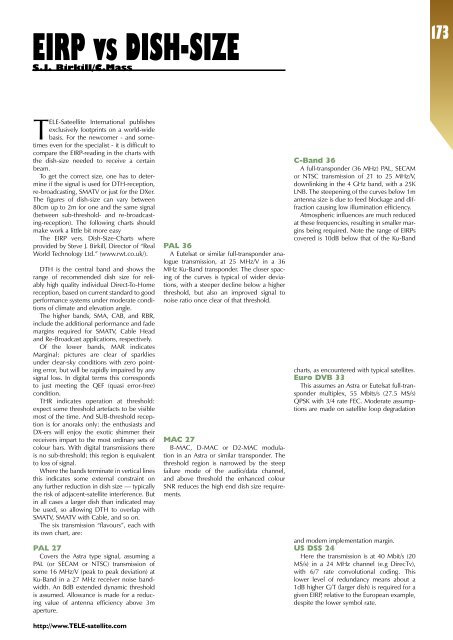TELE INTERNATIONAL - TELE-satellite International Magazine
TELE INTERNATIONAL - TELE-satellite International Magazine
TELE INTERNATIONAL - TELE-satellite International Magazine
You also want an ePaper? Increase the reach of your titles
YUMPU automatically turns print PDFs into web optimized ePapers that Google loves.
EIRP vs DISH-SIZE<br />
S.J. Birkill/C.Mass<br />
<strong>TELE</strong>-Sateellite <strong>International</strong> publishes<br />
exclusively footprints on a world-wide<br />
basis. For the newcomer - and sometimes<br />
even for the specialist - it is difficult to<br />
compare the EIRP-reading in the charts with<br />
the dish-size needed to receive a certain<br />
beam.<br />
To get the correct size, one has to determine<br />
if the signal is used for DTH-reception,<br />
re-broadcasting, SMATV or just for the DXer.<br />
The figures of dish-size can vary between<br />
80cm up to 2m for one and the same signal<br />
(between sub-threshold- and re-broadcasting-reception).<br />
The following charts should<br />
make work a little bit more easy<br />
The EIRP vers. Dish-Size-Charts where<br />
provided by Steve J. Birkill, Director of “Real<br />
World Technology Ltd.” (www.rwt.co.uk/).<br />
DTH is the central band and shows the<br />
range of recommended dish size for reliably<br />
high quality individual Direct-To-Home<br />
reception, based on current standard to good<br />
performance systems under moderate conditions<br />
of climate and elevation angle.<br />
The higher bands, SMA, CAB, and RBR,<br />
include the additional performance and fade<br />
margins required for SMATV, Cable Head<br />
and Re-Broadcast applications, respectively.<br />
Of the lower bands, MAR indicates<br />
Marginal: pictures are clear of sparklies<br />
under clear-sky conditions with zero pointing<br />
error, but will be rapidly impaired by any<br />
signal loss. In digital terms this corresponds<br />
to just meeting the QEF (quasi error-free)<br />
condition.<br />
THR indicates operation at threshold:<br />
expect some threshold artefacts to be visible<br />
most of the time. And SUB-threshold reception<br />
is for anoraks only: the enthusiasts and<br />
DX-ers will enjoy the exotic shimmer their<br />
receivers impart to the most ordinary sets of<br />
colour bars. With digital transmissions there<br />
is no sub-threshold; this region is equivalent<br />
to loss of signal.<br />
Where the bands terminate in vertical lines<br />
this indicates some external constraint on<br />
any further reduction in dish size — typically<br />
the risk of adjacent-<strong>satellite</strong> interference. But<br />
in all cases a larger dish than indicated may<br />
be used, so allowing DTH to overlap with<br />
SMATV, SMATV with Cable, and so on.<br />
The six transmission “flavours”, each with<br />
its own chart, are:<br />
PAL 27<br />
Covers the Astra type signal, assuming a<br />
PAL (or SECAM or NTSC) transmission of<br />
some 16 MHz/V (peak to peak deviation) at<br />
Ku-Band in a 27 MHz receiver noise bandwidth.<br />
An 8dB extended dynamic threshold<br />
is assumed. Allowance is made for a reducing<br />
value of antenna efficiency above 3m<br />
aperture.<br />
http://www.<strong>TELE</strong>-<strong>satellite</strong>.com<br />
PAL 36<br />
A Eutelsat or similar full-transponder analogue<br />
transmission, at 25 MHz/V in a 36<br />
MHz Ku-Band transponder. The closer spacing<br />
of the curves is typical of wider deviations,<br />
with a steeper decline below a higher<br />
threshold, but also an improved signal to<br />
noise ratio once clear of that threshold.<br />
MAC 27<br />
B-MAC, D-MAC or D2-MAC modulation<br />
in an Astra or similar transponder. The<br />
threshold region is narrowed by the steep<br />
failure mode of the audio/data channel,<br />
and above threshold the enhanced colour<br />
SNR reduces the high end dish size requirements.<br />
C-Band 36<br />
A full-transponder (36 MHz) PAL, SECAM<br />
or NTSC transmission of 21 to 25 MHz/V,<br />
downlinking in the 4 GHz band, with a 25K<br />
LNB. The steepening of the curves below 1m<br />
antenna size is due to feed blockage and diffraction<br />
causing low illumination efficiency.<br />
Atmospheric influences are much reduced<br />
at these frequencies, resulting in smaller margins<br />
being required. Note the range of EIRPs<br />
covered is 10dB below that of the Ku-Band<br />
charts, as encountered with typical <strong>satellite</strong>s.<br />
Euro DVB 33<br />
This assumes an Astra or Eutelsat full-transponder<br />
multiplex, 55 Mbits/s (27.5 MS/s)<br />
QPSK with 3/4 rate FEC. Moderate assumptions<br />
are made on <strong>satellite</strong> loop degradation<br />
and modem implementation margin.<br />
US DSS 24<br />
Here the transmission is at 40 Mbit/s (20<br />
MS/s) in a 24 MHz channel (e.g DirecTv),<br />
with 6/7 rate convolutional coding. This<br />
lower level of redundancy means about a<br />
1dB higher G/T (larger dish) is required for a<br />
given EIRP, relative to the European example,<br />
despite the lower symbol rate.<br />
173

















